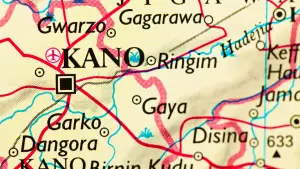The relationship between Oduduwa and Oranmiyan and their ties to the Benin and Yoruba empires have been a notable topic of discussion for historians and traditional scholars. However, the relevance of these two personalities cannot be overemphasized. Studies have shown that the history of both parties and their cultures are interwoven. We can’t tell one’s story without mentioning the other and this shows the rich history and relationships that both have shared over time.
This article aims to explore the complex ties between these two dynasties and the effect of their legacies on modern-day culture.
Oduduwa: Founder of the Yoruba Nation
Oduduwa is revered as the progenitor of the Yoruba people and his story is deeply rooted in the origin of Yoruba history and religion. He is said to have been sent to Earth from heaven by God (Olodumare) to bring order to the chaos that existed on Earth. He arrived at Ile-Ife with a bag filled with sand and a bird. The bird is said to have spread the sand thus forming the first land mass and human civilization.
Once on earth, Oduduwa is said to have united the existing group in Ile-ife. This created the first centralized government and made him its first ruler (Ooni). Under his reign, a strong government structure emerged that influenced other Yoruba kingdoms, making the city the spiritual and cultural center of the Yoruba empire.
Oduduwa is said to have fathered several children who formed other Yoruba kingdoms like Oyo, Ondo, and Ijebu. He is also said to have given birth to Oranmiyan who created the Oyo empire and played a key role in the Benin kingdom’s history. This also solidified the legacy of Oduduwa as the father of civilization with his descendants dulling different Yoruba states.
While mythology describes Oduduwa as a divine being. Historians claim that he might have migrated to Ile-ife from the east and united the people by conquest and diplomacy. Others believe that he was a Yoruba man who united several Yoruba groups making a vast kingdom. Oduduwa’s legacy continues to be a cornerstone of Yoruba identity, both politically and spiritually. His story is invoked in rituals, festivals, and royal ceremonies. Where the crown and scepter associated with him symbolize the divine authority of Yoruba kings. Whether viewed as a historical figure or a mythological being, Oduduwa remains a central figure in Yoruba tradition and continues to influence the culture and governance of the Yoruba people today.

Oranmiyan: The Bridge Between Yoruba and Benin
The legacy of Oranmiyan cuts across two great empires, the Yoruba and Benin empires. Oranmiyan is said to be a descendant of Oduduwa. Oranmiyan was known for his military prowess and leadership skills. Due to his leadership skills, The Benin Empire invited him to help solve a succession problem.
After arriving in Benin, Oranmiyan became the first Oba of Benin, marking the beginning of the strong connection between the Yoruba and Benin dynasties. However, the story also notes that Oranmiyan found the Benin people difficult to govern and referred to the land as “Ile-Ibinu,” meaning “land of vexation.” Despite the challenges, his influence in the Benin kingdom remained strong and many Oba’s were traced back to him.
After leaving Benin, he went back to Ile-ife where he established the Oyo empire which was one of the most influential states in West Africa. He is credited with founding Oyo-Ile, the capital of the Oyo Empire laying the groundwork for his military and political systems. Oranmiyan’s empire grew as he conquered other surrounding Yoruba lands making the Oyo empire a formidable force. With its sophisticated military and administration, it became a regional power lasting for centuries. Oranmiyan’s legacy continues to endure. His descendants, both in Benin and Oyo, carry on the traditions of their royal houses, paying homage to one of the most remarkable figures in West African history.
Similarities between both the Benin and Yoruba culture
The Benin and Yoruba people share a lot of cultural similarities because of their interwoven history. Oranmiyan influenced the Benin empire through his leadership systems and in turn learned some of the Benin ways which he may have implored in the Yoruba culture after his return. Here are some of these similarities below.
Monarchical Systems
Both the Benin kingdom and the Yoruba empire have long-lasting monarchical systems where the Oba of Benin and the Yoruba (such as the Ooni of Ife and Alaafin of Oyo) are not only ceremonial heads but also make executive decisions, albeit with a system of checks and balances. They are said to be chosen divinely and act as spiritual intermediaries between the people and God.
Religion and Spirituality
Both Benin and Yoruba share a deep sense of religion. The two groups share a number of similarities in their spiritual practices, particularly in the worship of deities, and reverence to ancestry. In Benin, it is believed that the ancestors watch over the living and can intercede on their behalf. Ehi, the individual’s spiritual double, is believed to be responsible for a person’s destiny and is closely tied to ancestor worship. Similarly, in Yoruba religion, ancestor reverence is central to maintaining harmony in the family and society.
Another interesting discovery is that the Benin and Yoruba cultures have similarities in gods. Pantheons of deity which have different functions. Ogun is revered in Yoruba and Benin culture as the deity of iron, war, and labor. Olokun, similar to Benin’s beliefs, governs the sea and wealth. Benin people call their deities Iku Obo while the Yoruba refer to theirs as Orisha.
Art and symbolism
The Benin and Yoruba also share similarities in their art and crafts and also in their symbolism. One of the major aspects of Benin art is bronze casting and metalwork. Elaborate plaques and sculptures are known worldwide for their detailed craftsmanship. These bronzes were primarily used to adorn the Oba’s palace and depict scenes of royalty, historical events, and religious ceremonies. Similarly, the Yoruba people are known for their metalwork, particularly in Ile-ife where traces of material and bronze sculptures dating back to the 12th century were discovered. These sculptures were mainly of kings and deities with lifelike details as tributes to these personalities.
Benin and Yoruba culture also share similar royal symbolisms like the adornment of regalia. In Benin, much of the art revolves around the figure of the Oba, who is often depicted wearing elaborate regalia and seated on a throne, symbolizing his divine authority and connection to the gods. Similarly, Yoruba art frequently depicts their kings (Obas) in ritualistic contexts, adorned in ceremonial attire that emphasizes their sacred role as mediators between the divine and the earthly. Symbols like the cowries, coral beads, scepters, and the throne carry spiritual significance representing the continuity of royal lineage and spiritual mandate.
Political Structure
Both societies developed complex and hierarchical political systems. In Benin, the Oba is supported by a council of chiefs called the Uzama Nihiron who help manage the kingdom’s affairs. Similarly, Yoruba city-states also have councils that assist the king in governance, such as the Oyo Mesi in Oyo and the Iwarefa in Ife. This system of checks and balances ensured stability and continuity in governance.
Conclusion
The legacy of Oduduwa and Oranmiyan has shaped the cultural heritage of the Benin and Yoruba people. Two great kingdoms that showed the rich heritage of Nigeria. Their stories have stood the test of time thriving even after the colonial era. Moving forward there is a great need to preserve and explore this tapestry of culture ensuring that their significance endures for generations to come.







